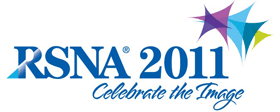
Abstract Archives of the RSNA, 2011
Sindhu John FRCR, Presenter: Nothing to Disclose
Angeline Poh MBBS, FRCR, Abstract Co-Author: Nothing to Disclose
Yizhi Lee, Abstract Co-Author: Nothing to Disclose
Le Roy Chong, Abstract Co-Author: Nothing to Disclose
Elizabeth Hui-Ying Chan MBBS,FRCR, Abstract Co-Author: Nothing to Disclose
C. C. Tchoyoson Lim MBBS, Abstract Co-Author: Nothing to Disclose
The benefits of mobile devices such as smart phones and laptops in emergency teleconsultation have variously been limited by small screen size or excess weight. Recently, tablet devices such as the iPad with its larger screen and higher resolution have potential to be successful remote image review devices for radiological studies. The objective of this study is to audit the accuracy of radiological diagnosis of CT and MRI studies made on the iPad tablet compared to PACS for common on-call conditions.
Annonymised DICOM images of 79 CT and 9 MRI studies reported by one Reporting Radiologist were retrospectively transferred from PACS to 3 iPads. A mixture of both normal and abnormal on-call CT and MRI cases representing a spectrum of common conditions during a busy call at a General Hospital were selected. Three Reviewing Radiologists independently viewed DICOM images using Osirix HD software and completed structured forms, documenting, 1. Major findings (primary diagnosis and other clinically important findings), 2. Minor findings (incidental or clinically unimportant findings) and 3. Feedback on the device. Major and Minor findings were compared to the Reporting Radiologist’s reports documented on PACS. Discrepancies were assessed by an independent reader, or by the reader reviewing the study again on PACS, to determine if discordance in diagnosis was attributed to variability in inter-observer interpretation.
88 studies were read by each radiologist for a total of 264 readings. The combined discrepancy rate for major findings was 3% (9/264). For minor findings the combined discrepancy rate was 5% (15/264). All reviewing Radiologists reported issues with stability and image manipulation with the program.
The iPad has potential to be used safely as an image review tool for on-call CT and MRI studies. Improvements to user interface and stability would be required. Further investigation is warranted.
With improved software applications, the Ipad has potential to be safely used to as a mobile device to review CT and MRI studies.
John, S,
Poh, A,
Lee, Y,
Chong, L,
Chan, E,
Lim, C,
How Good Is the iPad for On-call Radiology Review? Auditing Discrepancy in CT and MRI Reporting. Radiological Society of North America 2011 Scientific Assembly and Annual Meeting, November 26 - December 2, 2011 ,Chicago IL.
http://archive.rsna.org/2011/11013525.html

